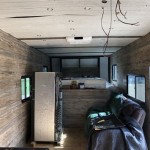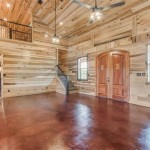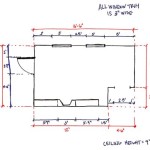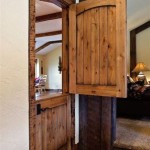How Many Gallons of Paint for a 3000 Square Foot House Interior?
Determining the precise amount of paint required for a 3000 square foot house interior is a crucial step in any painting project. Underestimating the paint needed can lead to frustrating interruptions and inconsistent finishes if a different batch has to be purchased. Overestimating, on the other hand, results in unnecessary expenses and potential storage issues. A careful calculation based on several factors will help ensure a smooth and cost-effective painting process.
The total square footage of a house’s interior is not the same as the square footage of the walls that need painting. The interior square footage typically refers to the floor area. Therefore, to calculate the paint needed, one must first determine the approximate wall surface area. This involves considering the height of the walls in each room, the number of rooms, and the presence of windows and doors that do not require painting.
Generally, one gallon of paint covers approximately 350 to 400 square feet in a single coat. This coverage can vary depending on the paint's quality, the texture of the wall, and the application method. Understanding these variables is essential for an accurate estimate. This article will explore the key considerations involved in calculating the paint requirements for a 3000 square foot house interior, offering a detailed guide to help homeowners and contractors avoid common pitfalls.
Calculating Wall Surface Area
The foundational step in determining the amount of paint required is calculating the total wall surface area. This process involves a series of measurements and estimations. First, measure the perimeter of each room individually. The perimeter is the sum of the lengths of all the walls in the room. Once the perimeter is known, measure the height of the walls from floor to ceiling. These two figures are then multiplied to give the approximate wall surface area for that room.
For example, if a room has a perimeter of 40 feet and a wall height of 8 feet, the wall surface area would be 40 feet x 8 feet = 320 square feet. This calculation needs to be performed for each room in the house. After calculating the wall surface area for each room separately, add the individual room areas together to obtain the total wall surface area of the house.
However, this initial calculation does not account for windows and doors, which will reduce the actual area that needs to be painted. Therefore, it is necessary to estimate the total area of the windows and doors in each room and subtract that figure from the room's wall surface area. A simple method is to measure the height and width of each window and door and multiply them together to get the area. Then, sum up the areas of all windows and doors in each room. Subtract this total from the initial wall surface area of that room to get the paintable wall area. Repeat this process for each room and then sum up all the paintable wall areas to get the final paintable wall surface area for the entire house.
For instance, consider a room with an initial wall surface area of 320 square feet. If the room contains a window measuring 3 feet by 4 feet (12 square feet) and a door measuring 3 feet by 7 feet (21 square feet), the total window and door area would be 12 + 21 = 33 square feet. The paintable wall area for that room would then be 320 - 33 = 287 square feet. This adjusted calculation provides a more accurate representation of the surface that needs to be painted.
Factors Affecting Paint Coverage
While the general guideline suggests that one gallon of paint covers 350 to 400 square feet, several factors can significantly impact this coverage rate. Understanding these factors is critical for fine-tuning the paint estimation and preventing potential shortages.
One primary factor is the paint's quality. Higher-quality paints often have better hiding power and spread more evenly than cheaper alternatives. This means that a single coat of high-quality paint may provide adequate coverage, whereas multiple coats of a lower-quality paint may be necessary. Investing in better quality paint can, therefore, reduce the overall amount of paint required.
The texture of the wall surface also plays a substantial role. Rough or porous surfaces, such as textured walls or unprimed drywall, tend to absorb more paint than smooth surfaces. This increased absorption leads to a lower coverage rate. When painting textured walls, it is generally necessary to plan for using more paint per square foot. Applying a primer before painting can help to seal the surface and minimize paint absorption, improving coverage and reducing the amount of paint needed.
The application method is another crucial determinant of paint coverage. Using a roller typically results in more consistent and efficient coverage compared to using a brush, especially over large areas. However, different types of rollers, such as those with longer naps, are designed for different textures and can affect the amount of paint applied. Incorrect application techniques, such as applying the paint too thinly or too thickly, can also lead to uneven coverage and increased paint consumption. Professional painters are usually more efficient in paint application and can achieve better coverage rates than inexperienced individuals.
The color being applied and the existing color of the wall also impact coverage. Painting a light color over a dark color, or vice versa, generally requires multiple coats to achieve uniform coverage. Priming the walls before painting can help to neutralize the existing color and improve the adhesion of the new paint, potentially reducing the number of coats needed and the amount of paint used.
Estimating Paint Needs for a 3000 Square Foot House
With an understanding of how to calculate wall surface area and the factors affecting paint coverage, it is now possible to estimate the paint needed for a 3000 square foot house interior. A typical 3000 square foot house may have approximately 2400 to 3000 square feet of wall surface to be painted, assuming standard 8-foot ceilings.
To provide an estimate, we will use the average coverage rate of 350 square feet per gallon, keeping in mind that this can fluctuate based on the factors previously discussed. If the total wall surface area is 2700 square feet and one coat is desired, dividing 2700 by 350 yields approximately 7.7 gallons of paint. This suggests that around 8 gallons of paint would be needed for a single coat.
However, it is nearly always recommended to apply at least two coats of paint for better coverage, durability, and color consistency. Therefore, the estimated amount of paint should be doubled. In this case, approximately 16 gallons of paint would be required for two coats. It is advisable to purchase 2-3 extra gallons of paint to ensure the entire project is completed with the same color batch and for future touch-ups.
These calculations serve as a general guideline. For walls with heavy texture or for situations requiring significant color changes, additional paint may be necessary. Consider purchasing a sample size of the chosen paint to test its coverage and color on a small, inconspicuous area of the wall before committing to a large purchase. This test will provide a more accurate understanding of the paint's coverage characteristics on the specific wall surface. Furthermore, engaging with a paint professional to receive a personalized estimate, considering the unique characteristics of the house, can be invaluable for ensuring an accurate paint calculation and preventing costly mistakes.
Remember, these estimates are based on general assumptions. It's always best to err on the side of caution and purchase slightly more paint than initially estimated. Unused paint can be stored properly for future touch-ups, ensuring that the finished interior remains pristine and well-maintained over time.
Ultimately, determining the exact amount of paint required for a 3000 square foot house interior requires a combination of careful measurement, understanding of paint characteristics, and consideration of individual project needs. By following the steps outlined in this article, homeowners and contractors can approach their painting projects with confidence, ensuring a successful and visually appealing outcome.

Cost To Paint A House Whole Painting Fixr

How Much Does It Cost To Paint The Interior Of A House In Paintrite Pros

Cost Of Painting A House Interior Comprehensive Guide
How Much Does It Cost To Paint The Interior Of A 2 500 Square Foot House Quora

How Much Does It Cost To Paint The Interior Of A House Angi

How Much Does Interior House Painting Cost In 2024 Forbes Home

2024 Interior Painting Costs Average Cost To Paint Of House

How Much To Paint The Entire Interior Of A House

Cost To Paint The Interior Of A House In 2024

How Much To Paint The Entire Interior Of A House
Related Posts








